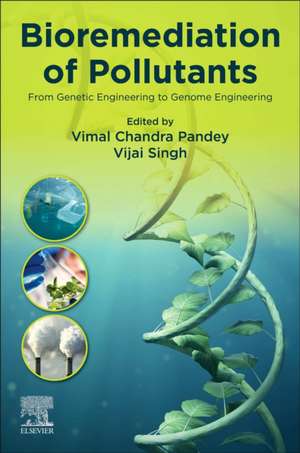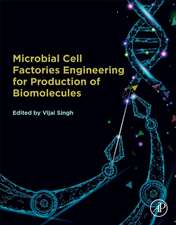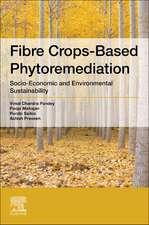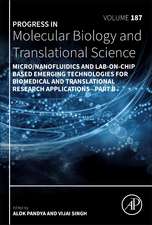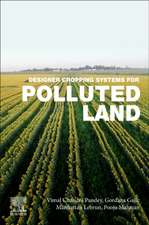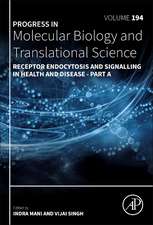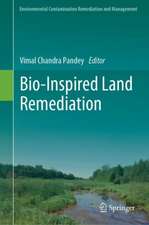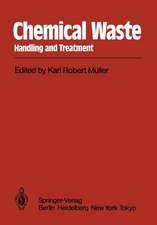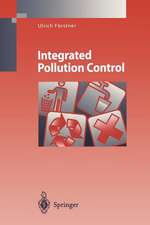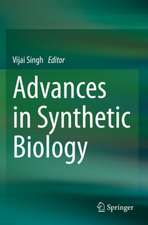Bioremediation of Pollutants: From Genetic Engineering to Genome Engineering
Editat de Vijai Singh, Vimal Chandra Pandeyen Limba Engleză Paperback – 2 iun 2020
Students and beginners in environmental science, researchers, soil scientists, genetic and genome engineers, stakeholders and policymakers interested in improving this rapidly growing area of research will find this resource extremely useful.
- Draws together research from eminent scientists from across the globe in the areas of phytoremediation and microbial remediation
- Includes case studies of engineered bacterial remediation
- Covers the genome editing CRISPR-Cas9 system that has been less explored in plants and microorganisms
Preț: 599.49 lei
Preț vechi: 820.13 lei
-27% Nou
Puncte Express: 899
Preț estimativ în valută:
114.74€ • 118.25$ • 96.87£
114.74€ • 118.25$ • 96.87£
Carte tipărită la comandă
Livrare economică 24 februarie-10 martie
Preluare comenzi: 021 569.72.76
Specificații
ISBN-13: 9780128190258
ISBN-10: 0128190256
Pagini: 488
Dimensiuni: 152 x 229 mm
Greutate: 0.65 kg
Editura: ELSEVIER SCIENCE
ISBN-10: 0128190256
Pagini: 488
Dimensiuni: 152 x 229 mm
Greutate: 0.65 kg
Editura: ELSEVIER SCIENCE
Public țintă
applied microbiologists, environmental scientists, soil scientists, environmental engineersCuprins
Part I Phytoremediation
1 Phytoremediation—a holistic approach for remediation of
heavy metals and metalloids
2 Role of potential native weeds and grasses for phytoremediation
of endocrine-disrupting pollutants discharged from pulp paper
industry waste
3 Transgenic plants in phytoremediation of organic pollutants
4 Progress, prospects, and challenges of genetic engineering in
Phytoremediation
5 Recent advances in phytoremediation using genome engineering
CRISPR-Cas9 technology
Part II Microbial Remediation
6 Endophytes—the hidden world for agriculture, ecosystem, and
environmental sustainability
7 Engineering bacterial aromatic dioxygenase genes to improve
Bioremediation
8 Microbial remediation progress and future prospects
9 Development of biologically-based activated carbon for advanced
water and wastewater treatment process
10 The role of microorganism bioremediation for sustainable
environment management
11 Bioreactor and bioprocess technology for bioremediation of
domestic and municipal wastewater
12 Metagenomics approach for bioremediation: challenges and
Perspectives
13 Microbial bioremediation of industrial effluents and pesticides
14 Synthetic biology approaches for bioremediation
15 Microbial indicators and biosensors for bioremediation
16 Biosurfactant-based bioremediation
17 Engineered bacteria for bioremediation
18 Biofilm in bioremediation
19 Genetic engineering approaches for detecting environmental
Pollutants
20 Current status, challenges, and future of bioremediation
21 Engineered microbes and evolving plastic bioremediation
technology
1 Phytoremediation—a holistic approach for remediation of
heavy metals and metalloids
2 Role of potential native weeds and grasses for phytoremediation
of endocrine-disrupting pollutants discharged from pulp paper
industry waste
3 Transgenic plants in phytoremediation of organic pollutants
4 Progress, prospects, and challenges of genetic engineering in
Phytoremediation
5 Recent advances in phytoremediation using genome engineering
CRISPR-Cas9 technology
Part II Microbial Remediation
6 Endophytes—the hidden world for agriculture, ecosystem, and
environmental sustainability
7 Engineering bacterial aromatic dioxygenase genes to improve
Bioremediation
8 Microbial remediation progress and future prospects
9 Development of biologically-based activated carbon for advanced
water and wastewater treatment process
10 The role of microorganism bioremediation for sustainable
environment management
11 Bioreactor and bioprocess technology for bioremediation of
domestic and municipal wastewater
12 Metagenomics approach for bioremediation: challenges and
Perspectives
13 Microbial bioremediation of industrial effluents and pesticides
14 Synthetic biology approaches for bioremediation
15 Microbial indicators and biosensors for bioremediation
16 Biosurfactant-based bioremediation
17 Engineered bacteria for bioremediation
18 Biofilm in bioremediation
19 Genetic engineering approaches for detecting environmental
Pollutants
20 Current status, challenges, and future of bioremediation
21 Engineered microbes and evolving plastic bioremediation
technology
